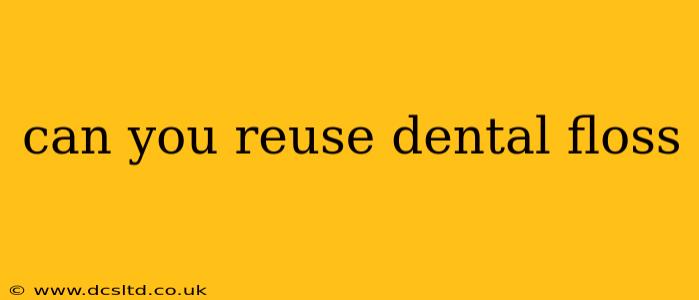Dental floss is a crucial tool for maintaining optimal oral hygiene. But can you reuse dental floss? The short answer is: no, you should not reuse dental floss. While it might seem wasteful to discard a seemingly clean piece of floss after a single use, reusing it poses significant risks to your oral health. This article will delve into the reasons why, addressing common questions and concerns surrounding floss reuse.
Why You Shouldn't Reuse Dental Floss
The primary reason you shouldn't reuse dental floss is the accumulation of bacteria and food particles. Once you've used floss to clean between your teeth, it becomes laden with plaque, food remnants, and potentially harmful bacteria. Reusing this contaminated floss introduces these harmful substances back into your mouth, potentially leading to:
- Gum disease (gingivitis and periodontitis): The bacteria trapped in used floss can irritate your gums, leading to inflammation and infection. This can progress to more serious gum disease, which can cause tooth loss.
- Cavities: Food particles left on the floss provide a breeding ground for bacteria that produce acids which erode tooth enamel, leading to cavities.
- Infection: In some cases, reusing contaminated floss can introduce harmful bacteria into your bloodstream, potentially leading to more serious infections.
What Happens When You Reuse Dental Floss?
Reusing dental floss is akin to using a dirty sponge to clean your dishes – you’re transferring the dirt and grime back onto the surface you’re trying to clean. The same principle applies to your teeth and gums. The microscopic bacteria and food particles are invisible to the naked eye, making it seem like the floss is clean enough to reuse, but this is a dangerous misconception.
What are the Alternatives to Reusing Dental Floss?
Instead of reusing dental floss, consider these alternatives:
- Using a fresh piece of floss each time: This is the most effective and safest way to maintain good oral hygiene. It's a small investment for significant health benefits.
- Switching to a different type of floss: Explore different types of floss, such as waxed or unwaxed, flavored or unflavored, to find one you prefer and are more likely to use consistently. Consider floss picks for easier handling.
- Using interdental brushes: These small brushes can be particularly effective for cleaning between teeth, especially for those with wider gaps.
Is there a way to sanitize used dental floss?
No. While you might consider rinsing or trying to clean the floss, it is impossible to effectively remove all bacteria and food particles. The intricate structure of the floss makes thorough cleaning extremely difficult. Attempting to sanitize used floss will likely prove futile and potentially risky.
How Often Should You Replace Your Dental Floss?
You should use a fresh piece of floss for each interdental cleaning. Do not reuse any section of the floss.
What are the benefits of using fresh dental floss every time?
The benefits of using fresh dental floss every time include preventing gum disease, avoiding cavities, reducing the risk of infection, and maintaining optimal oral health. It's a small but significant step in protecting your overall well-being.
Conclusion
Reusing dental floss is not advisable and poses significant health risks. While the cost of dental floss may seem insignificant, prioritizing oral health by using a fresh piece each time is a small price to pay for protecting your teeth and gums from potential harm. Maintaining good oral hygiene is essential for overall health and well-being; using fresh floss is a crucial part of that process.
